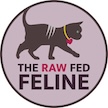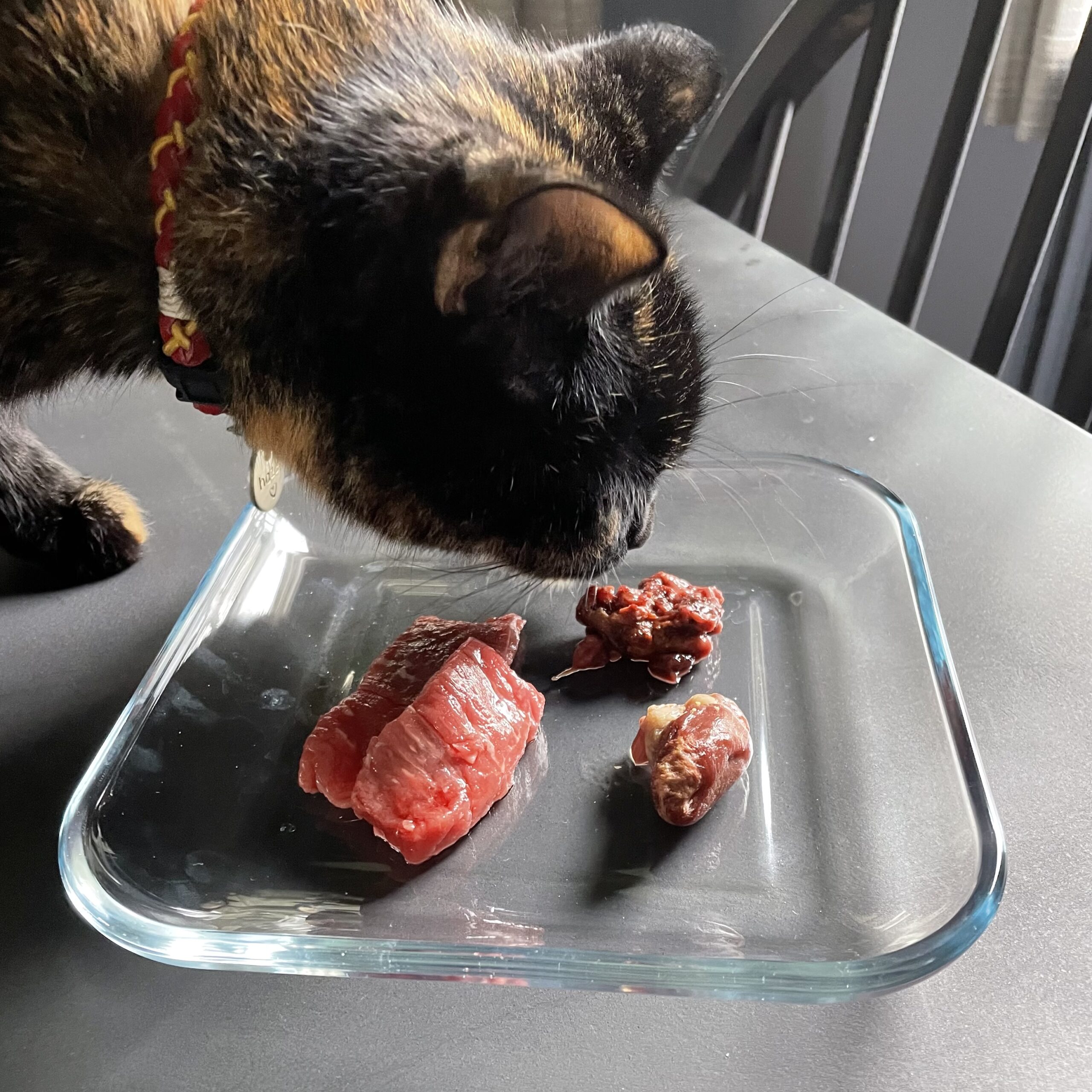I’d like to talk about the focus on individual nutrients and the National Research Council (NRC) numbers used when formulating raw diets. These nutrient values were never created nor intended to be used for making homemade raw diets with fresh whole foods. These numbers are used by the Association of American Feed Control Officials (AAFCO) to inform their guidelines for nutrient minimums and maximums to make sure that there is some uniformity for pet feed manufacturers to follow and to ensure the nutritional safety of commercial pet foods.
It is very important that commercial pet food manufacturers have guidelines to follow; however, I don’t think these same guidelines are actually relevant for making homemade raw diets with whole foods. Dry and canned foods are made with ingredients that are cooked under extreme heat and pressure. Synthetic vitamins and minerals are then added and are supposed to stay within those guidelines. This is drastically different from making homemade raw food with fresh whole food ingredients.
AAFCO and whole prey nutrient values
Let’s compare AAFCO recommendations with the nutrient values from a whole prey adult mouse.
Here are the nutrient guidelines on Dry Matter Basis from AAFCO for cats:
- Protein: 26-35%
- Fat: 9-13%
- Vitamin A: 3332-333,300 IU/kg
- Vitamin E: 40 IU/kg
- Ca: 0.6%
- P: 0.5%
- Mg: 0.4%
- Na: 0.2%
- K: 0.1-1.0%
- Cu: 5 mg/kg
- Fe: 80 mg/kg
- Zn: 75 mg/kg
- Mn: 7.6 mg/kg
Here are the nutrients on Dry Matter Basis for an adult mouse:
- Protein: 55.8%
- Fat: 23.6%
- Vitamin A: 578,272 IU/kg
- Vitamin E: 100.4 IU/kg
- Ca: 2.98%
- P: 1.72%
- Mg: 0.16%
- Na: NA
- K: NA
- Cu: 6.7 mg/kg
- Fe: 137.9 mg/kg
- Zn: 67.5 mg/kg
As you can see, the differences are rather striking.
However, a cat is not eating a diet of just adult mice. Cats are generalist carnivores. They eat a variety of whole prey animals in their environment. Old, young, male, female, sick, and healthy animals like different birds, mice, rats, voles, chipmunks, shrews, rabbits, etc. So then I looked at the nutrient profiles of other whole prey animals, not just adult mice.
additional whole prey nutrient values
Here are some examples:
Hamster
- Protein: 49.8%
- Fat: 34.7%
- Vitamin A: 26,666 IU/kg
- Vitamin E: 12.4 IU/kg
- Ca: 2.51%
- P: 2.03%
- Mg: 0.12%
- Na: 0.46%
- K: 0.88%
- Cu: 12.0 mg/kg
- Fe: 237.0 mg/kg
- Zn: 94.0 mg/kg
- Mn: 45.0 mg/kg
Rabbit domestic
- Protein: 72.1%
- Fat: 13.0%
- Vitamin A: 6200 IU/kg
- Vitamin E: NA
- Ca: 5.93%
- P: 3.43%
- Mg: 0.18%
- Na: 0.26%
- K: 0.72%
- Cu: 4.6 mg/kg
- Fe: 100.0 mg/kg
- Zn: 84.0 mg/kg
- Mn: 2.4 mg/kg
Rat >50g
- Protein: 61.8%
- Fat: 32.6%
- Vitamin A: 151,389 IU/kg
- Vitamin E: 139.2 IU/kg
- Ca: 2.62%
- P: 1.48 %
- Mg: 0.08%
- Na: NA
- K: NA
- Cu: 6.3 mg/kg
- Fe: 148.0 mg/kg
- Zn: 62.1 mg/kg
- Mn: 11.0 mg/kg
You can see there is quite a range of nutrient values between these animals and differences from the AAFCO recommendations.
averages of whole prey nutrient values
I then calculated the averages from 13 whole prey birds and mammals. The results are similar to Plantinga’s findings regarding the protein and fat content of feral cats’ diets, which you can read here.
Here are the averages:
- Protein: 57.8%
- Fat: 29.6%
- Vitamin A: 134,977 IU/kg
- Vitamin E: 71.76 IU/kg
- Ca: 2.98%
- P: 1.90%
- Mg: 0.11%
- Na: 0.43%
- K: 0.76%
- Cu: 7.81mg/kg
- Fe: 240.25 mg/kg
- Zn: 83.44 mg/kg
- Mn: 13.7 mg/kg
Averages of course can be skewed by any outlier values. For example, the vitamin A in adult mice is significantly higher than any of the other animals with 578,272 IU/kg. On the other end of the spectrum, rabbits have only 6200 IU/kg of vitamin A.
The amount of iron from several bird species was significantly higher than other animals. The Meadow Pipit has 400 mg/kg and Rooks have 475 mg/kg of iron. In contrast, the iron in rabbits is 100 mg/kg and in rats is 148 mg/kg. Hamsters have 45 mg/kg of manganese, while rats have 11 mg/kg and rabbits only 2.4 mg/kg.
These are huge ranges!
ranges of whole prey nutrient values
Speaking of ranges, let’s look at the nutrient value ranges from these same whole prey animals (n=13):
- Protein: 49.8-72.1%
- Fat: 13-34.7%
- Vitamin A: 6200-578,272 IU/kg
- Vitamin E: 12.4-139.2 IU/kg
- Ca: 1.54-5.93%
- P: 1.14-3.43%
- Mg: 0.07-0.18%
- Na: 0.26-0.83%
- K: 0.47-1.28%
- Cu: 4.6-12 mg/kg
- Fe: 100-500 mg/kg
- Zn: 62.1-120 mg/kg
- Mn: 2.4-45 mg/kg
Balance over time
What can we learn from this? In my opinion, we can start to understand that cats are not naturally eating meals meeting AAFCO or NRC recommendations! Cats are eating a variety of animals that offer an incredibly wide range of nutrient amounts. This is how “balance over time” works. I think this suggests that cats and kittens are much more robust in their capacity to eat a diet balanced over time than we give them credit for.
I think we have inadvertently bought into the story from pet food manufacturers that our cats need “complete and balanced” nutrition at every meal. However, they are not going to develop nutrient deficiencies if they don’t have the “exact” amount of anything in any particular meal, and most importantly, they are not going to be missing anything if they eat a diet consisting of biologically appropriate whole foods.
“complete & balanced” is just marketing
Which brings me to my next point. The nutrient guidelines for AAFCO, which are based on NRC recommendations, assume that cats will be eating one food forever. The whole notion of feeding a variety is pretty much non-existent in the world of pet food marketing. They promote their foods as being “complete and balanced” and as the only food your cat will ever need. This is their way of getting you and your wallet to be a customer for life.
If you are only feeding one brand of food for the lifetime of your cat, then yes, you most certainly would need to pay much closer attention to the individual nutrient amounts. But keep in mind that this still doesn’t mean that the food has an exact amount of any given nutrient. It only means that it has over the minimum or under the maximum. It is nowhere near as specific as it purports itself to be.
But only feeding one brand of any food would not be in line with how cats are designed to eat and not recommended for several important reasons that I discussed here.
challenges
It may be that your cat has significant allergies, intolerances, or other health issues that interfere with being able to eat a variety of whole foods. In this case, it would be prudent to pay attention to the nutrient profiles of the foods your cat can eat and see if you need to make any adjustments.
Additionally, you want to pay very close attention when using synthetic supplements in your homemade food given their higher rates of absorption. Considering AAFCO recommendations when using synthetic supplements is more in line with what those recommendations were designed for.
What we should focus on
But in general, for healthy cats and kittens, I don’t think DIY raw feeders need to be stressing over individual nutrients when using whole foods. There is no need to try and meet exact numbers. It breeds perfectionism and is overwhelming, off-putting, and unnecessary. And most importantly, those numbers aren’t related to raw feeding or to how cats naturally eat anyway.
There can be a real fear of stepping away from these numbers though. The fear of feeding an unbalanced diet runs deep. And of course, no one wants to harm their cat. DIY raw feeders want to feel legitimate, to prove they are feeding a healthy and “complete” diet. Meeting those NRC or AAFCO numbers provides this sense of legitimacy and security. But ultimately, these numbers are a false sense of security as they were never meant for homemade raw diets using whole foods in the first place.
based on whole prey
So if not NRC or AAFCO numbers, then what? We don’t want anyone to feed their cat a piece of raw chicken and think that is providing an appropriate diet. I think feeding a prey model raw diet, which means feeding a variety of meats, bone, and organs in ratios that approximate cats’ natural prey, is a much better place to focus our energy when it comes to making homemade raw food.
I think the legitimacy and security raw feeders seek can be found by providing a diet that more closely aligns with how cats naturally eat.
Ultimately, I think it makes much more sense to use Mother Nature’s guidelines when it comes to feeding our raw fed felines rather than ones created for ultra processed commercial foods using synthetic vitamins and minerals.



2 responses to “Cats Don’t Actually Follow NRC or AAFCO Recommendations”
Thank you for this very informative email. I am currently feeding a variety of human grade muscle meat with a meal completer which meets AAFCO standards & recently I’ve started to wonder if they need the completer ALL the time. I’ve noticed that mostly they like it, then they reject it. I also give them Feline Natural freeze dried for variety.
My main stumbling block to total DIY raw is that one puss has mega colon & not allowed bone, so I’d be keen to learn how they can get enough calcium etc without the completer. You’ve given me food for more thought!
You can still make DIY without bone. You can use finely ground eggshell in lieu of bone with adult cats. You use 1/2 tsp per pound of food.
I’m so glad that you found the blog information helpful. 🙂